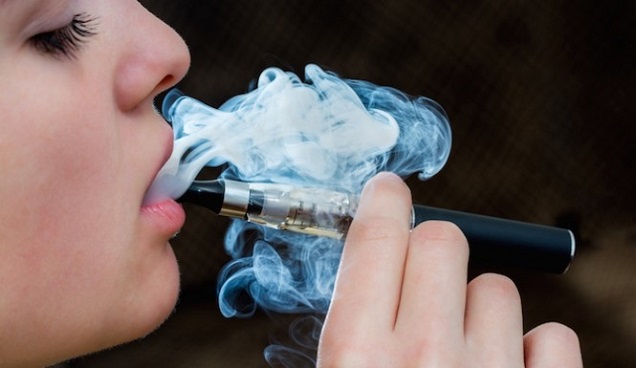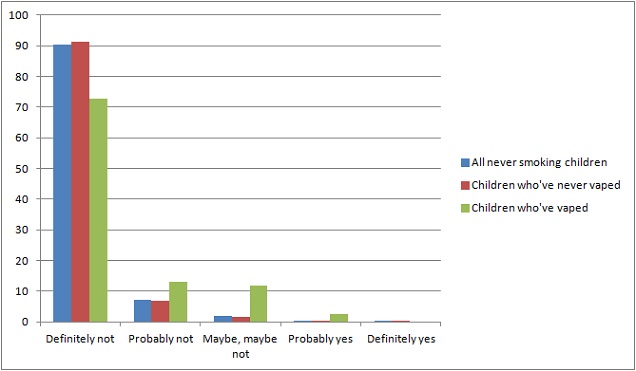
The big problem with all the concern about youth e-cigarette use is that the evidence to date has shown no reason to be particularly worried about it: almost all of those who use e-cigarettes are smokers, and never-smokers (children or adults) only become vapers very rarely. However, a new study may finally provide them with a scrap of ammunition in their misguided fight to quash the proliferation of a device with the potential to save millions of lives around the world. The research, coming from Wales in the UK, found that among 10 to 11 year olds, the number who’d ever tried e-cigarettes was actually higher than the corresponding number for tobacco cigarettes. As you may expect (given the complete lack of concerning evidence to date), the findings really aren’t all that concerning (unless you’re super-worried about kids trying something once), and claims of “reinforcing concerns” of a potential gateway to smoking tobacco are utter bunk.
Summary
- The survey looked at exposure to second-hand smoke and e-cigarette use in 1,578 kids from Wales aged 10 to 11.
- For vaping, having tried it “once,” “more than once” or “never” were the only options; there was no measure of current vaping.
- 48 percent of smokers had ever tried an e-cigarette, compared to just 5 percent (one in 20) of never smokers. Kids in this study were more likely to have tried vaping than smoking, altogether.
- While 91.3 percent of never smokers who hadn’t vaped said they’d “definitely not” smoke in the next two years, only 72.7 percent of those who’d vaped said they definitely wouldn’t.
- Only two never smokers who’d vaped said they’d “probably” smoke in the next two years, the rest answering “definitely not,” “probably not” or “maybe.” This was taken as “tentative support” for the gateway hypothesis by the researchers.
- The associations between vaping and “intentions” to smoke could go in either direction: the intentions may come before vaping, or vice-versa. This study is unable to establish the existence of cause and effect or its direction.
The Study – Investigating Second-Hand Smoke Exposure and E-Cig Use in Kids
The new findings come from the CHETS study (available for free) – which stands for Childhood (CH) Exposure to Tobacco Smoke. This originally aimed to investigate the exposure to second-hand smoke for kids aged 10 to 11 in Wales, initially conducted before and one year after the introduction of an indoor smoking ban. The most recent data comes from 2008, and this study aims to both follow-up on the issue of second-hand smoke exposure and investigate the use of e-cigarettes, in particular, the relationship between vaping, parental smoking or vaping, peer smoking and intentions to smoke cigarettes.
To determine use of e-cigarettes, the available options were simply having vaped once, more than once or never. Needless to say, none of these enable the researchers to investigate current, regular use of e-cigarettes (the primary potential concern for any rational person), and so no such information is available from this research. They were also asked about whether they’d heard of e-cigarettes and whether they’d seen them being used in various places.
What They Found – One in 20 Never-Smoking Kids Has Tried an E-Cigarette
The data comes from a total of 1,578 pupils from schools in Wales. 67 percent of respondents had heard of e-cigarettes, and many had seen them being used in the specified places (for example, 32 percent had seen someone vaping outside a bus station and 20 percent had outside the cinema). Notably, all children were more likely to report seeing vaping outside than inside, indicating (even in the absence of any rules on indoor vaping in the UK) that most vapers opt to stand outside. 17 percent of the respondents reported having at least one parent who vapes (73 percent of whom also smoked), compared to 39 percent who had at least one parent using tobacco.
Of the children in the study who reported having smoked, 48 percent had also tried e-cigarettes. Counting the non-smokers alone, just 5 percent of them (77 kids) had ever tried an e-cigarette, with this being more common in boys than girls. Overall, 6 percent of the sample had tried an e-cigarette compared to just 2 percent who’d smoked, suggesting that kids in the UK may be more likely to try vaping than smoking. For the kids with two parental figures smoking, 12 percent report having ever vaped, and for those with two vaping parental figures, 19 percent had tried an e-cigarette. Similarly, 18 percent of kids with friends who smoke had tried an e-cigarette, compared to 5 percent of those without friends who smoke.
Do E-Cigarettes Increase Intentions to Smoke?
The researchers also investigated intentions to smoke within the next two years, finding that the vast majority of the never smokers in the sample (98 percent) said that they would either probably not or definitely not smoke. For never-smokers who’d used an e-cigarette, the percentage saying they definitely or probably won’t smoke decreased to 85.7 percent. However, it’s clear that the overwhelming majority still have no intention to smoke, and a further 11.7 percent of the never-smokers who’d vaped merely said “maybe, maybe not.”

The authors argue that “having used an e-cigarette is associated with weaker anti-smoking intentions,” on the basis of the fact that 72.7 percent of the never smokers who’d ever vaped said they definitely wouldn’t smoke, compared to 91.3 percent of never-smokers-never-vapers. However, the ever e-cig users were more likely to say probably not or maybe, and only 2.6 percent of those who’d vaped (2 individuals) said they’d probably smoke in the next two years. None of the never-smokers who’d vaped said they’d definitely smoke, whereas one of the never-smokers-never-vapers did.
According to the discussion section of the paper, this is the part of the research that offers “tentative support” for the gateway hypothesis. As Carl V. Phillips noted in response to a similar US-based study, saying that you definitely won’t do something, as a young person, is a quite a statement, unless you’re talking about doing something extreme like “committing genocide.” Many adults still smoke, and who knows what you’ll want to try when you get a bit older? Can you really be so sure that you’ll never try a cigarette as you approach your teen years?
The real question is: are the kids who say they “probably” won’t smoke showing signs of “weaker anti-smoking intentions” or just being a bit more realistic than their peers who claim it’s a certainty? And this is all before you address the big problem with the association between e-cigarette use and smoking intentions: the glaringly obvious difference between a kid who decides to try an e-cigarette and one who doesn’t. Could it be, perhaps, that those who try vaping (which looks a little like smoking) are already more inclined to smoke than those who don’t?
The authors themselves note this, pointing out the inability of the research to establish cause and effect: “while findings are consistent with a hypothesis that e-cigarette use increases children’s intention to smoke, it is possible that intention to smoke drives e-cigarette use rather than the other way around.”
So the “tentative support” for the gateway hypothesis essentially boils down to this. The very weak observed association (based on data from just 77 never-smokers who’d ever vaped – just two of whom said they’d “probably” smoke in the next two years) could go in either direction. Either kids with no interest whatsoever in smoking just arbitrarily decide to try vaping (something quite like smoking) for no apparent reason, and then develop greater intentions of smoking as a result, or kids who already have an interest in smoking (or at least less of an issue with it) try e-cigarettes under the rightful assumption that it’s a safer way to explore that interest. The former would suggest a gateway to tobacco, but is also obviously ridiculous, whereas the latter suggests e-cigs are actually providing a way for kids with an interest in smoking to explore that interest in a less harmful way.
The Best Evidence for Concerns About Youth Vaping is Still Weak

The idea that the “intention” to smoke finding supports the gateway hypothesis is absurd, but the fact that these 10 to 11 year olds were more likely to have vaped than smoke is the sort of thing anti-vaping organizations have been waiting for. The big problem is that this study didn’t even try to find out about regular use, and the number of never smokers who vaped “more than once” is conspicuously absent from the write-up.
In short: just 5 percent of never-smokers had ever tried an e-cigarette, and you can bet that almost all of these were “just once” experimenters. But expect to see this finding repeated a lot, because it’s actually among the best evidence they have so far. That’s right; a small fraction of never-smokers just trying vaping once (possibly without nicotine) is the best evidence they have for their manufactured panic.

